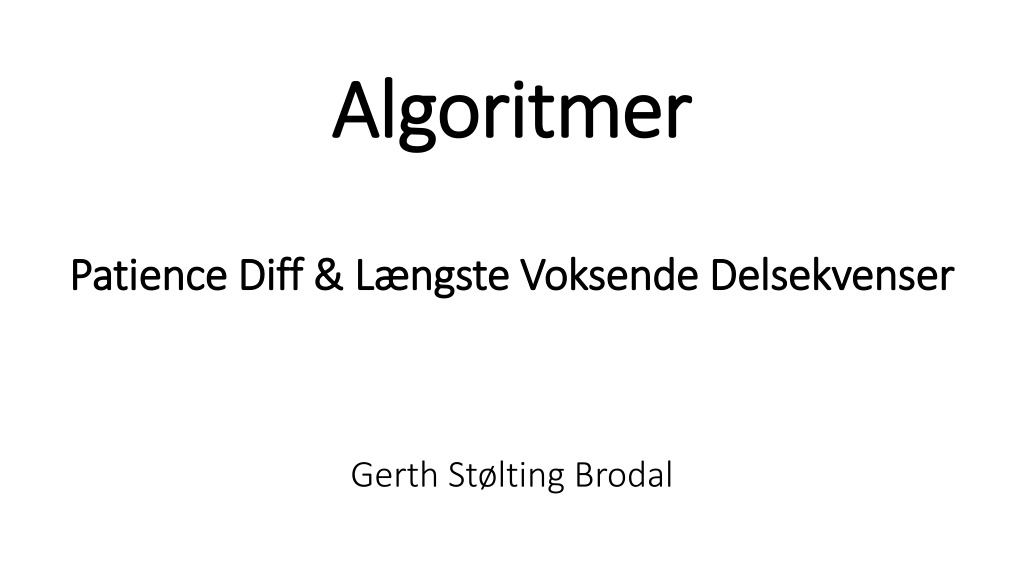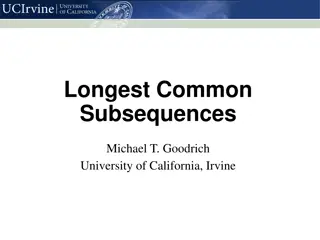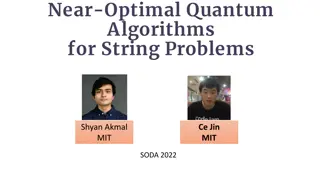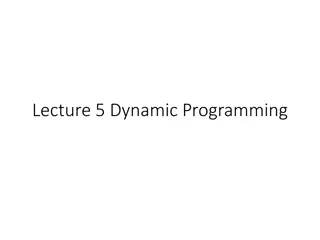Algoritmer - Patience Diff. & Longest Increasing Subsequence
This content covers various algorithms including Patience Diff, Longest Increasing Subsequences, searching in sorted lists, and code snippets in C programming. It also touches on concepts like fibonacci sequence and factorial calculation. The images displayed showcase code examples and algorithmic concepts in a visually engaging manner.
Uploaded on Feb 18, 2025 | 0 Views
Download Presentation

Please find below an Image/Link to download the presentation.
The content on the website is provided AS IS for your information and personal use only. It may not be sold, licensed, or shared on other websites without obtaining consent from the author.If you encounter any issues during the download, it is possible that the publisher has removed the file from their server.
You are allowed to download the files provided on this website for personal or commercial use, subject to the condition that they are used lawfully. All files are the property of their respective owners.
The content on the website is provided AS IS for your information and personal use only. It may not be sold, licensed, or shared on other websites without obtaining consent from the author.
E N D
Presentation Transcript
Algoritmer Algoritmer Patience Diff & Patience Diff & L ngste L ngste Voksende Voksende Delsekvenser Delsekvenser Gerth St lting Brodal
Sgning S gning i i Sorteret Sorteret L Liste iste 3 7 9 11 13 27 33 37 42 89 1+ log2 n sammenligninger
A.c B.c #include <stdio.h> #include <stdio.h> // Frobs foo heartily int frobnitz(int foo) { int i; for(i = 0; i < 10; i++) { printf("Your answer is: "); printf("%d\n", foo); } } int fib(int n) { if(n > 2) { $ diff A.c B.c 3,4c3 < // Frobs foo heartily < int frobnitz(int foo) --- > int fib(int n) 6,7c5 < int i; < for(i = 0; i < 10; i++) --- > if(n > 2) 9,10c7 < printf("Your answer is: "); < printf("%d\n", foo); --- > return fib(n-1) + fib(n-2); 11a9 > return 1; 14c12,13 return fib(n-1) + fib(n-2); } return 1; } // Frobs foo heartily int frobnitz(int foo) { int i; for(i = 0; i < 10; i++) { printf("%d\n", foo); } } int fact(int n) { if(n > 1) { return fact(n-1) * n; } return 1; } int main(int argc, char **argv) { frobnitz(fib(10)); } int main(int argc, char **argv) { frobnitz(fact(10)); }
Patient Diff (Bram Cohen) Fors ger at lave l sbar og meningsfuldt ouput frem for mindst mulig Anvendes i Bazaar versionskontrolsystemet (bazaar-vcs.org)
A.c A.c B.c B.c 00 00 #include <stdio.h> 01 02 // Frobs foo heartily 03 int frobnitz(int foo) 04 { 05 int i; 06 for(i = 0; i < 10; i++) 07 { 08 printf("Your answer is: "); 09 printf("%d\n", foo); 10 } 11 } 12 13 int fact(int n) 14 { 15 if(n > 1) 16 { 17 return fact(n-1) * n; 18 } 19 return 1; 20 } 21 22 int main(int argc, char **argv) 23 { 24 frobnitz(fact(10)); 25 } 25 } 00 #include <stdio.h> 01 02 // Frobs foo heartily 03 int frobnitz(int foo) 04 { 05 int i; 06 for(i = 0; i < 10; i++) 07 { 08 printf("Your answer is: "); 09 printf("%d\n", foo); 10 } 11 } 12 13 int fact(int n) 14 { 15 if(n > 1) 16 { 17 return fact(n-1) * n; 18 } 19 return 1; 20 } 21 22 int main(int argc, char **argv) 23 { 24 frobnitz(fact(10)); 00 #include <stdio.h> 01 02 int fib(int n) 03 { 04 if(n > 2) 05 { 06 return fib(n-1) + fib(n-2); 07 } 08 return 1; 09 } 10 11 // Frobs foo heartily 12 int frobnitz(int foo) 13 { 14 int i; 15 for(i = 0; i < 10; i++) 16 { 17 printf("%d\n", foo); 18 } 19 } 20 21 int main(int argc, char **argv) 22 { 23 frobnitz(fib(10)); 24 } 24 } 00 #include <stdio.h> 01 02 int fib(int n) 03 { 04 if(n > 2) 05 { 06 return fib(n-1) + fib(n-2); 07 } 08 return 1; 09 } 10 11 // Frobs foo heartily 12 int frobnitz(int foo) 13 { 14 int i; 15 for(i = 0; i < 10; i++) 16 { 17 printf("%d\n", foo); 18 } 19 } 20 21 int main(int argc, char **argv) 22 { 23 frobnitz(fib(10)); Patience Diff 11 12 1) Find linjer der forekommer pr cis n gang i begge tekster 2) Find l ngste voksende (f lles) delsekvens p disse 3) Gentag (rekursivt) p blokkende 14 15 17 08 21
Lngste voksende delsekvens L ngste voksende delsekvens 30 83 73 80 59 63 41 78 68 82 53 31 22 74 6 36 99 57 43 60 Slet s f tal som muligt fra en liste af tal, s de resterende tal st r i voksende orden.
Stning S tning ( (Erdos Erdos og og Szekeres Szekeres, 1935) , 1935) Enhver sekvens af n tal har en voksende eller aftagende delsekvens af l ngde mindst n . 3 1 4 17 6 42 10 8 13 11 28 (voksende) 24 3 12 16 7 14 26 8 20 2 1 (aftagende)
Opsummering Opsummering Designe algoritmer Analysere algoritmer vre gr nser asymptotisk analyse Analysere problemer nedre gr nse Invarianter Korrekthedsargument






















